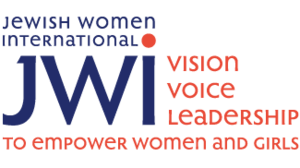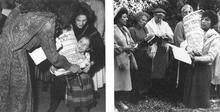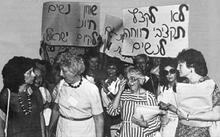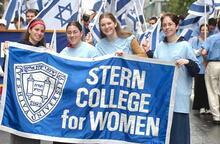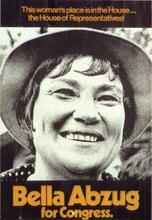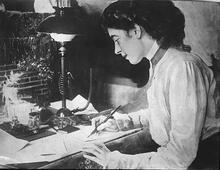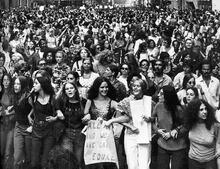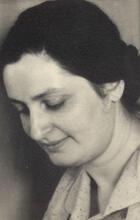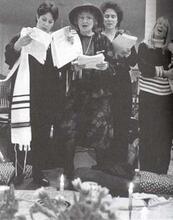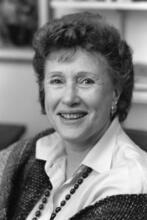B'nai B'rith Women
Although the first chapter of B’nai B’rith Women was created in 1909, World War I dramatically expanded women’s role in social work. During World War II, BBW aided European Jews and participated in civil defense projects in the United States, as well as jobs in industries such as manufacturing that had been traditionally limited to men. BBW also made significant contributions to help the newly created state of Israel. Although gender roles after the war reverted to a more conventional structure, BBW continued its work, and in the 1960s, shifted its efforts to reflect the antipoverty and feminist campaigns of the period. B’nai B’rith Women fully declared its independence from B’nai B’rith Interntional by changing its name to Jewish Women International in 1995.
Pre-World War I
When the first permanent chapter of B’nai B’rith Women (BBW) was founded in 1909 in San Francisco, its aim was “to promote sociability among [B’nai B’rith] lodge members and their families.” B’nai B’rith, American Jewry’s oldest and largest fraternal and service organization, did not permit women’s auxiliaries until 1897, when Ruth Lodge No. 1, Daughters of Judah, enjoyed a very brief existence.
In 1909, searching for a more permanent venue, the Columbia Auxiliary of B’nai B’rith announced a safe, socially acceptable goal: genteel entertainment, designed to attract the young, single adult members of B’nai B’rith with whist parties, boating parties, picnics, and dances. Auxiliary members pressed for the official recognition by B’nai B’rith, but the men’s Grand Lodge refused, setting a precedent that would continue for decades.
The Columbia Auxiliary was part of a movement by nineteenth-century American women who had begun to emerge out of the home and into the public sphere partly by creating their own voluntary social and charitable associations. Jewish women followed the pattern of their Christian peers by forming Jewish women’s groups. Some of these groups became associated with male-run synagogues and charitable and fraternal organizations. Entertainment served as an effective icebreaker, easing the women into the more serious activities being undertaken by other women’s groups across the country.
Before the outbreak of World War I, over a dozen B’nai B’rith women’s auxiliaries were scattered from San Francisco to New Jersey. They expanded into cultural activities, philanthropy, and community service, such as financial support of orphanages and homes for the elderly. Their announced aims were to perpetuate Jewish culture, enrich their communities, and ensure the religious survival of their sons and daughters. Their unannounced goals included sociability and the first steps toward personal independence.
Most women’s auxiliaries included male members as “mentors” or trustees. The men’s motives were often highly personal. One “mentor” noted that men attended auxiliary meetings to “seek, like Ponce de León, the ‘spring of eternal youth.’” Despite their appreciation for the female sex, however, the men permitted only two representatives at Grand Lodge meetings—“a voice, but no vote.”
War Years
World War I changed the women’s pattern of service. As men went off to war, American women expanded their work and volunteer activity by serving in hospitals and settlement houses, offices, and factories. B’nai B’rith auxiliary members, like other women, rushed into patriotic volunteer activity. They filled women’s wartime roles, which had been growing since the Crimean War: entertaining and knitting for soldiers, rolling surgical dressings, nursing in military hospitals, helping ambulance crews, and even driving ambulances themselves. They also started their own fund for the relief of Jews in Europe.
The growing emphasis on service activities brought the number of new auxiliaries to seventeen by the end of the war. B’nai B’rith Women was not directly involved in the suffragist movement, but women’s activism seems to have influenced the group. By 1929, the beginning of the Great Depression, 6000 women belonged to 83 auxiliaries.
The 1930s saw the rise of social conservatism in the United States and fascism in Europe. Women who had won the vote now returned to the nineteenth-century women’s tradition of exercising political influence through voluntary associations. BBW membership increased accordingly, reaching 12,000 women in 103 auxiliaries by 1935. Despite their growing political force, however, the women failed in their renewed bid for B’nai B’rith Supreme Lodge official recognition.
In 1940, the term “auxiliaries” was dropped in favor of “chapters,” and the Women’s Districts formally organized the Women’s Supreme Council as a national coordinating body for the districts and chapters. Judge Lenore Underwood Mills of San Francisco was elected the first national president. A formal liaison with B’nai B’rith was established, and the groundwork was laid for auxiliary representation at B’nai B’rith commissions and conventions.
As Nazi persecution of European Jews increased and war drew closer, the auxiliaries engaged in relief work for Jewish victims. At the same time, America’s isolationism, social antisemitism, and sympathy for fascism in some quarters, particularly in the U.S. State Department, made it particularly important to Jewish organizations that they prove their patriotism. Eager to demonstrate their support for America, some auxiliaries embarked on civil defense projects before the attack on Pearl Harbor.
At the beginning of World War II, BBW included 248 chapters with more than 40,000 members, and produced its first monthly publication, B’nai B’rith Women. In 1941, voteless women delegates protesting their status created a stir at the B’nai B’rith Supreme Lodge convention.
As America entered the war, BBW chapters threw themselves into the war effort: They sold bonds, knitted and sewed, and rolled bandages. They provided USO-type entertainment for servicemen. They donated collapsible wheelchairs, bookmobiles, portable radios, and other recreational equipment to military hospitals. The organization received a citation from the U.S. Treasury Department for its sale of war bonds.
But the war years were also a period of emancipation for women. In an era when Rosie the Riveter was a national hero, BBW members drove ambulances and worked in armament factories. BBW helped recruit and assist military service women. The organization also focused on the women’s concern for Jews in Europe, sending money to London for refugee orphans and Jewish working girls whose homes had been destroyed. Mourning President Franklin Roosevelt’s death in 1945, B’nai B’rith Women established the Four Freedoms Library.
B’nai B’rith Girls
The war also brought to a peak the organization’s great interest in serving young girls. In 1927, it created Junior Auxiliaries, also called Girls’ Auxiliaries, BB Junior Leagues, and BZB (a substitute for AZA, the Aleph Zadik Aleph group for boys). Junior activities were primarily educational, religious, and recreational. During World War II, these youth groups contributed to the American and Canadian war effort.
B’nai B’rith Women saw B’nai B’rith Girls as a favorite child. “These young women are our daughters, who we hope will take our places...in promoting the ideals we work for,” said Mrs. Anita Perlman, the national chair of junior girls in 1941. Perlman worked to establish a national girls’ group similar to Aleph Zadik Aleph. In 1942, the AZA accepted BBW’s proposal to make B’nai B’rith Girls a national organization, and to form the B’nai B’rith Girls Youth Commission, governing both AZA and BBG. By 1944, B’nai B’rith Girls formally achieved national status.
Israel
By the end of the year, B’nai B’rith Women counted over 100,000 members and moved toward strengthening the work in Palestine that it had begun during the war. Members raised $1 million, plus food, clothes, and equipment to assist the fledgling State of Israel in 1948.
In Israel, turned over Home to B’nai B’rith leaders in 1943, B’nai B’rith Women assumed responsibility for its maintenance. Expanding the home over the years, BBW reopened the original building in 1972 as a residential treatment center for emotionally disturbed boys, which it still maintains. BBW also continues to provide a network of social services in Israel.
The Postwar Years
America’s postwar idyll nursed a decade that swung gradually between traditionalism and rebellion. Men returned from war, and the mostly male-run businesses boomed. Women returned to children, service clubs, and the suburbs. Women’s small victories came quietly. The long battle for a vote in the traditionally male B’nai B’rith organization was won in 1953, when, for the first time, women delegates voted at the B’nai B’rith Supreme Lodge convention.
Sympathetic to the influx of postwar immigrants, BBW undertook a variety of projects, particularly in human relations and prejudice reduction. In cooperation with the Anti-Defamation League of B’nai B’rith, the organization sponsored interfaith seminars, developed school curricula in prejudice reduction, and introduced its popular Dolls for Democracy program in diversity for elementary school children in 1954.
Social service projects ranged from helping displaced persons to assisting the American Tuberculosis Association, to providing donors for blood banks. During this period, support of B’nai B’rith Hillel organizations on college campuses began, as BBW raised funds to furnish Hillel buildings and sponsor Hillel programs.
In 1957, membership totaled 132,000 women in 768 chapters in the United States and Canada, with 41 chapters in foreign countries. The organization’s name was changed officially to B’nai B’rith Women. Headquarters were moved to the new B’nai B’rith building in Washington, D.C., which houses the Four Freedoms Library maintained today by B’nai B’rith International.
Transition to Feminism
The 1960s became the turning point in B’nai B’rith Women’s activism. Inspired by the presidency of John F. Kennedy, BBW became involved in the War on Poverty’s anti-illiteracy and antipoverty programs, as well as in the needs of senior citizens, including senior housing. However, the burgeoning women’s movement and the early Jewish feminist movement of the 1970s became even more critical influences, turning the organization toward feminist issues.
In 1971, a year before Ms. magazine’s first issue was published, former New York congresswoman Bella Abzug was given an award at the BBW District One Convention. Lamenting women’s exclusion from political power, she called for delegates to “challenge a way of life that has oppressed 53 percent of the population.” Abzug’s award illustrated B’nai B’rith Women’s new focus on political activism for women’s issues. At the convention, members urged greater opportunities for women to hold political office and to participate equally in appointive posts at all levels; called for business and industry to count volunteer experience as qualification for job entry and urged public and private support of day-care centers.
BBW transformed itself into a politically conscious and activist feminist organization, campaigning for such issues as free choice in abortion, equal Social Security benefits for women, assistance for the displaced homemaker, women’s and infants’ health care, and reducing teenage pregnancy. The organization also focused on programs to meet the growing needs of women on their own, career women, older women, and young family women juggling families and careers.
The members advocated national health insurance, improving the image of women in the media, curbing teenage pregnancy, and improving the legal status of homemakers. B’nai B’rith Women became the first Jewish organization to back the Equal Rights Amendment in 1971, and members campaigned steadily for the amendment’s ratification. BBW became a nongovernmental organization with consultative status at the United Nations and participated in the UN World Conference for Women.
At the same time, BBW continued its Jewish focus, particularly as a convener of the Women’s Plea for Soviet Jews and Human Rights, and as an advocate for Jewish family issues, support for youth programs, and the BBW Children’s Home outside Jerusalem.
Jewish Women International
By 1980, BBW had 114,000 members and 914 chapters in the United States and Canada with associate units overseas and boasted some political influence on women’s issues. Its members included the astronaut Judith Resnick and Maryland House of Delegates representative Ida Ruben. Nevertheless, B’nai B’rith Women experienced a decline in membership similar to that of other volunteer organizations: It had lost 15,000 members since its height in the 1950s. As its National Jewish Monthly acknowledged, “The future for women’s volunteer service organizations has never been more uncertain. As more and more women join, and remain in, the work force, and as their personal responsibilities increase, will they have the time and be willing to do volunteer work?”
In the late 1980s, BBW faced a takeover attempt by B’nai B’rith International (BBI). The men’s organization had begun to discuss absorbing B’nai B’rith Women in the mid-1980s. Some BBI leaders argued that men and women should be equal partners in B’nai B’rith International, and that a separate women’s organization was unnecessary and out of step with the times.
But BBW believed that declining BBI membership and financial problems were the real reasons the men wanted to take over the women’s organization. Moreover, BBW leadership felt that independence was critical, with more advantages than disadvantages in having an all-women organization, including more leadership opportunities for women. A struggle began, noted Lilith magazine, “over who will attract and then speak for those Jewish women who want to affiliate with B’nai B’rith.”
In September 1988, the BBI biennial conference, concerned with declining enrollment, decided that the organization should admit women. Following the BBI decision, BBW passed a resolution affirming its status as a separate legal entity identified with B’nai B’rith, thus pitting the organizations against each other.
B’nai B’rith International instituted a “hostile takeover” attempt in January 1989. It ordered BBW to rescind the “autonomy” statement and threatened litigation and expulsion of B’nai B’rith Women from the BBI “family.” Negotiations failed, and BBW moved out of the B’nai B’rith building in November.
BBW argued that keeping its historical autonomy meant the continuation of a strong women’s voice speaking out on women’s and family issues. The critical issue, noted Lilith, was whether organizations such as B’nai B’rith International, “still largely led by men even after two decades of Jewish feminist activism, [would] ever take these issues as seriously as women must.”
All attempts to avoid an organizational schism failed. Taking its case to the press, B’nai B’rith Women insisted that its concerns were to protect B’nai B’rith Women’s organizational integrity, maintain its role in the B’nai B’rith International “family,” secure continued use of the BBW name, and protect the BBI insurance coverage of BBW members and the pension coverage of its employees. Press reports sympathized with the women.
By fall 1990, BBW and BBI reached an agreement recognizing that B’nai B’rith Women was an independent, self-governing organization affiliated with B’nai B’rith. BBW kept its name, in return for payment to the B’nai B’rith Youth Organization and Hillel, recognizing its emotional ties to B’nai B’rith International.
B’nai B’rith Women fully declared its independence by changing its name to Jewish Women International in 1995. It announced its intention of continuing “cordial relations” with B’nai B’rith and maintaining its support of the B’nai B’rith Youth Organization, Hillel, and the Anti-Defamation League.
Jewish Women International continued its effective programs and political advocacy on issues of concern to women. Nevertheless, it struggles with the same dilemma as other women’s organizations: the difficulty of recruiting new members from women juggling families and careers, with little time left for volunteerism.
A History of B’nai B’rith Women (1984).
Joselow, Beth. “Women on Their Own.” National Jewish Monthly (August-September 1980).
Kuzmack, Linda Gordon. Woman’s Cause: The Jewish Woman’s Movement in England and the United States, 1881–1933 (1990): 30.
Lilith (Spring 1990): 4.
Moore, Deborah Dash. B’nai B’rith and the Challenge of Ethnic Leadership (1981): 13; “A Story of 50 Years.” B’nai B’rith Women’s World (April 1959): 4–10, (Winter 1990, Fall 1990, Summer 1993, Winter 1994, Summer 1994, Fall 1995, Spring 1996).

